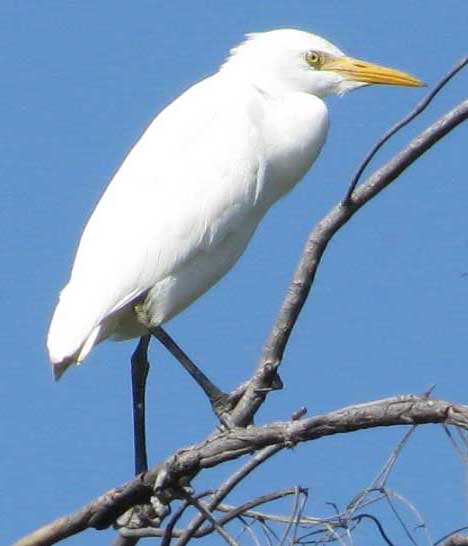Excerpts from Jim Conrad's
Naturalist Newsletter
from the January 5, 2009 Newsletter issued from Mayan Beach Garden Resort 20 kms north of Mahahual; Caribbean coastal beach and mangroves, ~N18.89°, ~W87.64°, Quintana Roo state, MÉXICO
CATTLE EGRET
You see lots of white herons and egrets here but you always need to look closely to figure out which species you're seeing. Most sightings turn out to be Cattle Egrets, BUBULCUS IBIS, often seen on the sand road around water puddles stabbing at crabs and other critters. You can see one below:

Breeding Cattle Egrets show conspicuous tawny-buff patches on their crown, chest and back, but you can see that the one in the picture is pure white. Other all-white herons and egrets showing up here are the Great Egret, Snowy Egret, immature Little Blue Heron, and "white morphs" of the Reddish Egret and Great Blue Heron. You have to remember certain features of each to separate them.
For example, Snowy Egrets have yellow feet and immature Little Blue Herons have blue-gray beaks with dark tips, all unlike our Cattle Egret. The main features indicating that what's in they picture is a Cattle Egret are the yellow bill, black feet and, more than anything, the thick, stubby neck. Often, however -- as in the picture -- the bird has his neck scrooched down so you can't see how sinuous it is.
You can compare the above picture with one of an immature Little Blue Heron who often drops by here at www.backyardnature.net/n/09/090105cf.jpg.
This Little Blue Heron could almost be a Reddish Egret "white morph" but Reddish Egrets display shaggy heads and necks.
Why should so many herons and egrets be white, at least during part of their lives? One theory is that white birds are harder for prey in the water to see against the bright sky. Clay Green and Paul Leberg at the University of Louisiana tested this hypothesis with mosquitofish and crayfish and found that crayfish reacted the same to white and dark birds, but that mosquitofish actually avoided dark birds more than white.
So, who knows why so many herons and egrets are white?
from the January 11, 2015 Newsletter issued from Río Lagartos, on the Yucatan Peninsula's northern coast (~N21.60°, ~W88.16°), Yucatán state, MÉXICO
CATTLE EGRETS & LOCUSTS
In extreme northeastern Yucatán State this week our truck passed through a small flight of them as late afternoon sunlight caught in their silvery wings, surrounding us with fluttering, drifting globes of radiance. There must have been more of them out in the savanna beside the road, for that's where a flock of Cattle Egrets was busily gobbling up what could be caught, the flock keeping up with the locusts' general southerly movement. Below, you can see some of the egrets at work:

Cattle Egrets are well known for this kind of behavior. Often they follow farmers' plows collecting earthworms. Though they favor insects, especially grasshoppers and other small arthropods, they also catch frogs, fish, lizards, small birds and rodents. In areas where people set grassland ablaze thinking it improves grass production, as here, Cattle Egrets follow along beside the fire, preying on small creatures trying to escape the flames.